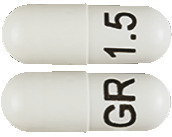Notes
Distributed by Seqirus (Australia) Pty Ltd
1 Name of Medicine
Cariprazine.
2 Qualitative and Quantitative Composition
Reagila contains cariprazine, a novel atypical antipsychotic agent. Each Reagila hard capsule contains cariprazine hydrochloride corresponding to 1.5 mg, 3 mg, 4.5 mg or 6 mg of cariprazine.
For the full list of excipients, see Section 6.1 List of Excipients.
3 Pharmaceutical Form
Hard capsule that is filled with white to yellowish white powder mixture.
Reagila 1.5 mg. Hard gelatin capsule with white opaque cap and white opaque body imprinted with "GR 1.5" on the capsule body with black ink.
Reagila 3 mg. Hard gelatin capsule with green opaque cap and white opaque body imprinted with "GR 3" on the capsule body with black ink.
Reagila 4.5 mg. Hard gelatin capsule with green opaque cap and green opaque body imprinted with "GR 4.5" on the capsule body with white ink.
Reagila 6 mg. Hard gelatin capsule with purple opaque cap and white opaque body imprinted with "GR 6" on the capsule body with black ink.
4 Clinical Particulars
4.9 Overdose
For information on the management of overdose, contact the Poisons Information Centre on 13 11 26 (Australia).
Symptoms. Accidental acute overdose (48 mg/day) was reported in one patient. This patient experienced orthostasis and sedation. The patient fully recovered the same day.
Management of overdose. There is no specific antidote to Reagila, therefore, management of overdose should concentrate on supportive therapy including maintenance of an adequate airway, oxygenation and ventilation and management of symptoms.
Cardiovascular monitoring should commence immediately, including continuous electrocardiographic monitoring for possible arrhythmias. In case of severe extrapyramidal symptoms, anticholinergic medicinal products should be administered. Since Reagila is highly bound to plasma proteins, haemodialysis is unlikely to be useful in the management of overdose. Close medical supervision and monitoring should continue until the patient recovers.
5 Pharmacological Properties
5.3 Preclinical Safety Data
Genotoxicity. Cariprazine was not mutagenic in the in vitro bacterial reverse mutation assay, nor clastogenic in the in vitro human lymphocyte chromosomal aberration assay or in the in vivo mouse bone marrow micronucleus assay. However, cariprazine increased the mutation frequency in the in vitro mouse lymphoma assay under conditions of metabolic activation at cytotoxic concentrations.
The major human metabolite DDCAR was not mutagenic in the in vitro bacterial reverse mutation assay, but induced a small increase in chromosomal aberrations in the in vitro human lymphocyte chromosomal aberration assay at cytotoxic concentrations in the presence of metabolic activation.
Based on the weight of evidence, cariprazine and its major metabolite DDCAR have negligible genotoxic potential.
Carcinogenicity. There was no increase in the incidence of tumours following daily oral administration of cariprazine to rats for 2 years and to Tg.rasH2 mice for 6 months at doses that are up to 4 and 19 times respectively, the MRHD based on AUC of total cariprazine, (i.e. sum of AUC values of cariprazine, DCAR and DDCAR).
Rats were administered cariprazine at oral doses of 0.25, 0.75, and 2.5 (males)/ 1, 2.5, and 7.5 mg/kg/day (females) which are 0.2 to 1.8 (males)/ 0.8 to 4.1 (females) times the MRHD based on AUC of total cariprazine.
Tg.rasH2 mice were administered cariprazine at oral doses of 1, 5, and 15 (males)/ 5, 15, and 50 mg/kg/day (females) which are 0.6 to 7.9 (males)/ 2.6 to 19 (females) times the MRHD based on AUC of total cariprazine.
Animal toxicology. Retinal pathology. Reagila caused bilateral cataract and secondary retinal changes (retinal detachment and cystic degeneration) in the dog. The exposure (AUC of total cariprazine) at the no-observed-adverse-effect-level (NOAEL) for ocular toxicity (2 mg/kg/day) was 4.2-fold the clinical AUC exposure for total cariprazine at the MRHD. Increased incidence and severity of retinal degeneration/atrophy was observed in albino rats in the 2-year study at 0.75 mg/kg/day (0.6 times the clinical AUC exposure for total cariprazine at the MRHD). Cataracts were not observed in other repeat dose studies in pigmented mice or albino rats.
Phospholipidosis. Phospholipidosis was observed in the lungs of rats, dogs, and mice (with or without inflammation) and in the adrenal gland cortex of dogs at clinically relevant exposures. Inflammation was observed in the lungs of dogs dosed for 1 year with a NOAEL of 1 mg/kg/day (approximately 2 times the MRHD based on AUC of total cariprazine). No inflammation was observed at the end of 2-month drug-free period at an exposure 4 times the clinical exposure at the MRHD; however, inflammation was still present at higher doses.
Effects on adrenal gland. Hypertrophy of the adrenal gland cortex was observed in rats (females only) and in mice following daily oral administration of cariprazine for 2 years and 6 months, respectively. Reversible hypertrophy/hyperplasia and vacuolation/ vesiculation of the adrenal gland cortex were observed following daily oral administration of cariprazine to dogs for 1 year. The NOAEL was 2 mg/kg/day which is 4 times the MRHD based on AUC of total cariprazine.
The relevance of these findings to human risk is unknown.
6 Pharmaceutical Particulars
6.7 Physicochemical Properties
Cariprazine HCl (active entity) is a white or almost white crystalline powder. It is freely soluble in methanol, slightly soluble in dichloromethane and, ethanol, very slightly soluble in acetone, acetonitrile and water, and practically insoluble in isopropyl alcohol and N,N-dimethylformamide and has a pKa of 8.2.
Chemical structure.
https://stagingapi.mims.com/au/public/v2/images/fullchemgif/CSCARIPR.gif CAS number. Cariprazine: [839712-12-8].
Cariprazine hydrochloride: [1083076-69-0].
7 Medicine Schedule (Poisons Standard)
Prescription Only Medicine (S4).
Summary Table of Changes
https://stagingapi.mims.com/au/public/v2/images/fulltablegif/REAGILST.gif

